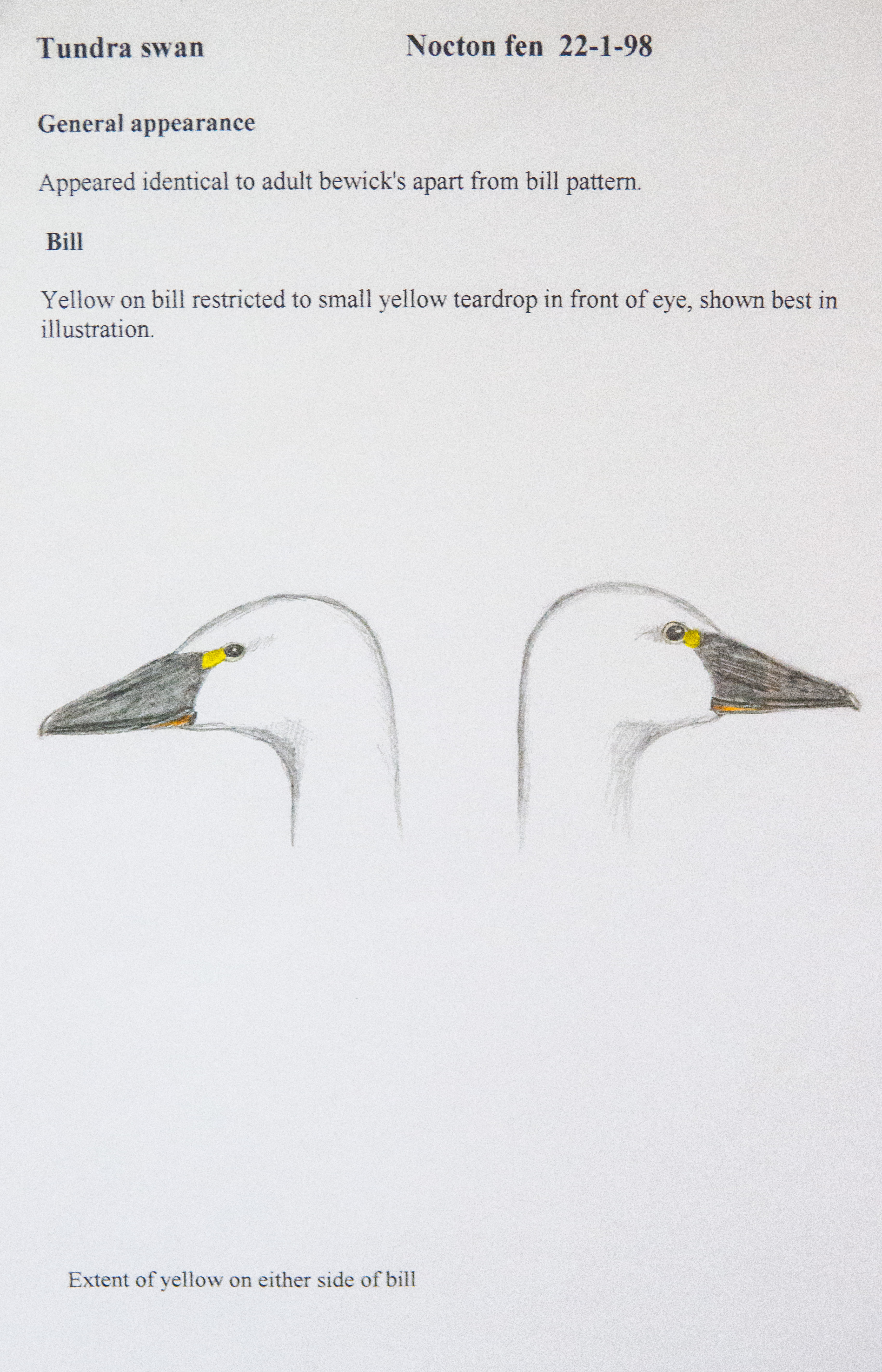Whistling Swan Cygnus columbianus columbianus
Vagrant. Breeds in Arctic N America and extreme NE Siberia; winters in western and coastal eastern USA and N Mexico.
This species and Bewick's Swan (see previous account) are races of Tundra Swan, Cygnus columbianus. One record on January 22nd, 1998 at Nocton Fen. Only the second British ‘Whistling Swan’, with previous records 1986-1990 in Hampshire and (mainly) Somerset referring to a returning individual. There have been no other British records. Allowing for duplication, three is the revised total for Ireland and there are five accepted records for the Netherlands ( all between 1976-1998), so this is a truly rare bird in Europe (Rogers et al 1999). There have been no other British, Irish or Dutch records since; all records of Whistling Swan in the Netherlands are currently being re-examined by the Dutch rarity committee (M. Miske, Dutch Birding, pers. comm, April 2018).

Whistling Swan, C.c.columbianus, Nocton Fen, January 22nd 1998;
photograph of the original sketch by the finder, Kevin Durose, from the BBRC files
Identification requires careful observation. In an analysis of 300 Whistling Swans and 104 Bewick's the average proportions of yellow on the bill were 3.1% for Whistling Swans and 31.5% for Bewick's, with discrete ranges; this is believed to be the only reliable field characteristic (The Auk 97: 697-703). Apparently voice differences also offer a clue to the experienced observer (Svensson et al 2017).
| Site | First date | Last date | Count | Notes |
| Nocton Fen | 22/01/1998 | 1 | Adult |
Finder's report: Whistling Swan at Nocton Fen, January 22nd, 1998; first county record.
by Kevin Durose.
On January 22nd I was making one of my regular visits to Nocton Fen with the main aim of looking for raptors. At around 13.00hr. I noticed a group of Bewick’s Swans feeding unusually close to the road. After a couple of minutes, I noticed that one of the birds appeared to have an all-dark bill. I realised that the bird could well be a Whistling Swan, the North American counterpart of Bewick’s Swan. I studied the bird and the accompanying Bewick’s Swans for about 10 minutes, and noticed the limited amount of yellow on the bill, which appeared about right for Whistling Swan. I drove a little closer to the bird and could see the clearly defined and symmetrical yellow ‘tear drop’ in front of both eyes. The only reservation I had was the possibility of discolouration due to some kind of staining although the Bewick’s Swans and the bird in question showed no abnormalities in feather colouration, in fact all the birds appeared to be in clean condition.
I decided to get even closer and carefully reversed my car along the farm track, with my telescope set up on the passenger seat. Getting closer all the time, within a few minutes I had the swan down to about 100 metres and obtained excellent views through my 27x telescope. At this range any form of bill staining was ruled out, the bird showed the classic bill pattern for Whistling Swan. I studied the swan for about an hour, until the bird was eventually lost from view as the group worked their way across the fen (which is surprisingly undulating). The farm tracks on the Fen are private and as the swan by now was out of view and the light was fading fast, I decided not to release the news.
In general appearance the bird appeared identical to adult Bewick’s apart from bill pattern. Yellow on the bill was restricted to a small yellow ‘tear drop’ in front of the eye, the extent of which appeared to be more or less identical on both sides of the bill (see sketch). Next morning I visited the Fen but unfortunately the Whistling Swan was not present with the Bewick’s herd.
References
Evans, M.E. and Sladen, W.J.L. (1980). A comparative analysis of the bill markings of Whistling and Bewick's Swans and out-of-range occurrences of the two taxa. The Auk 97: 697-703.
Rogers, M.J. and the rarities Committee (1999). Report on Rare Birds in Great Britain in 1998. British Birds 92: 554-609.
Svensson, L., Mullarney, K. and Zetterstrom, D. (2017). Collins Bird Guide. Nature Guide, William Collins and Bonnier Fakta (Pubs.)
(Account prepared April 2018; includes all records to 2016).

